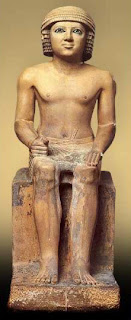Furniture of Queen Hetepheres
Signs and cemeteries of Queen Hetep, the wife of Sneferu and the mother of Khufu, was found intact in his tomb on the Giza plateau improvised from a museum in 1925 at Harvard, Boston expedition led by Egyptologist George Reisner. According to the inscriptions died while his son was on the throne.
Its exquisite wood furniture, including a portable canopy, was partially covered with gold leaf. Funerary objects including pots, vases of gold, a box containing eight small alabaster vases filled with toilet oils and Kohl, gold manicure tools, bracelets, anklets and various, and the four canopic jars.
The canopic jars were placed in a box made from a block of translucent alabaster and divided into four squares. Each compartment contains a mass composed of internal organs-the liver, lungs, intestines and stomach, removed during the mummification process and immersed in a weak solution of soda. These vessels and chest are the oldest ever found in ancient Egypt.
Portable Canopy The queen was covered with gold leaf and was equipped with a curtain for privacy and protection against insects and cold. The curtain was kept in a box with inlaid gold cartridge with her husband Snefru. The furniture consisted of two chairs and a bed frame with headboard, covered in gold leaf and probably used during the life of the queen. The panel on the footboard of the bed was inlaid with a blue and white floral design.
The wood of the sedan was badly damaged and had to be replaced. The end brings Pali palmiforme with capitals and layers of chair cover with gold edges and boundaries. An ebony horizontal panel is inscribed in gold with the name of the queen and the title "Mother of the King of Upper and Lower Egypt," follower of Horus, who takes care of business in the harem, whose every word is for you, daughter of the god, his loins, Hetep ". QueenHetepheres name means" satisfied, it is his face. "
It seems that his funeral, nearly three small pyramids beside the Great Pyramid of his son was quickly adopted after its original grave was violated. Probably he was first buried next to her husband pyramids at Dahshur, but its effects have been taken to his grave after the funeral Giza flight. Arrangement of the contents of the tomb was the reserve rule, with personal items to be placed within the first and last the coffin. However, the sarcophagus, although carefully buried, has been shown to be empty and the body of the Queen has never been found.
He had probably been stolen, and the tombs of the original thieves for valuables wrapped in mummy or associations during his journey from Giza to Dahshur. Anyway, no one dared tell him that the king's son, who knew first at the tomb had been disturbed, but believed to be buried safely.
The tomb has a shaft 99 feet deep ending in a burial chamber. No superstructure was added so that would remain completely hidden from the eyes of tombaroli future.
They look for many years to restore this collection, which now gives us a clear idea of the quality and type of furniture used by the royal family of the fourth dynasty. A set of real mobile equally impressive is represented on wall reliefs of the tomb of Queen Meresankh III, even at Giza.
.jpg)



























.jpg)
